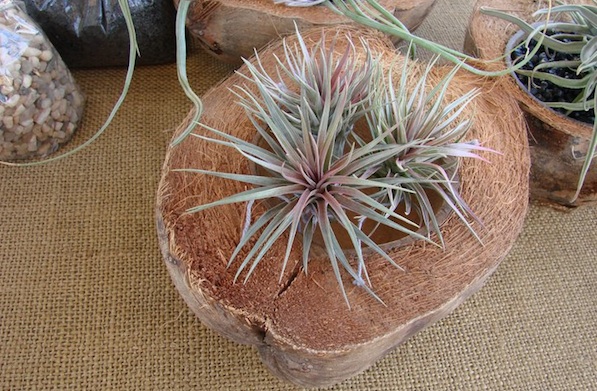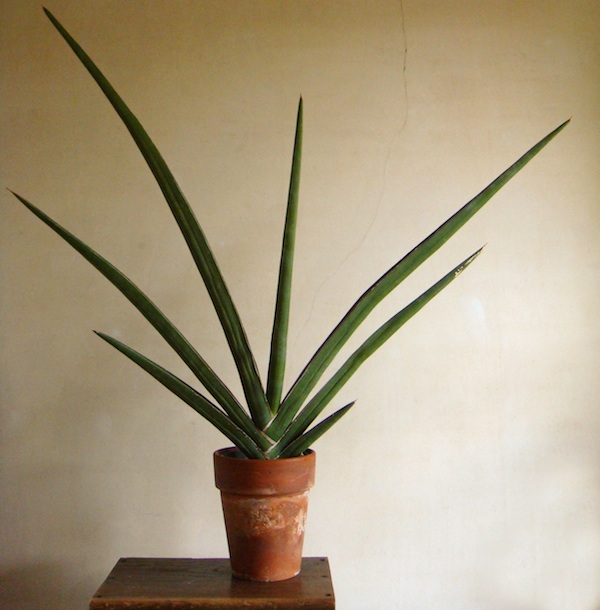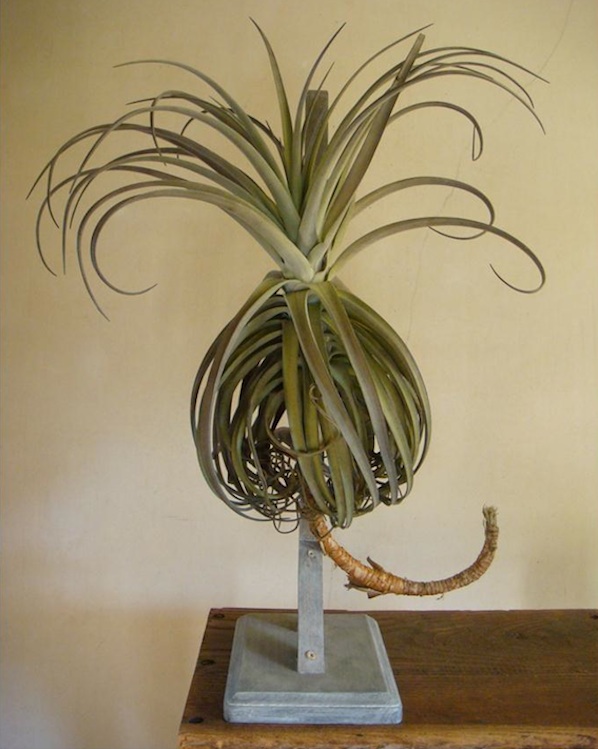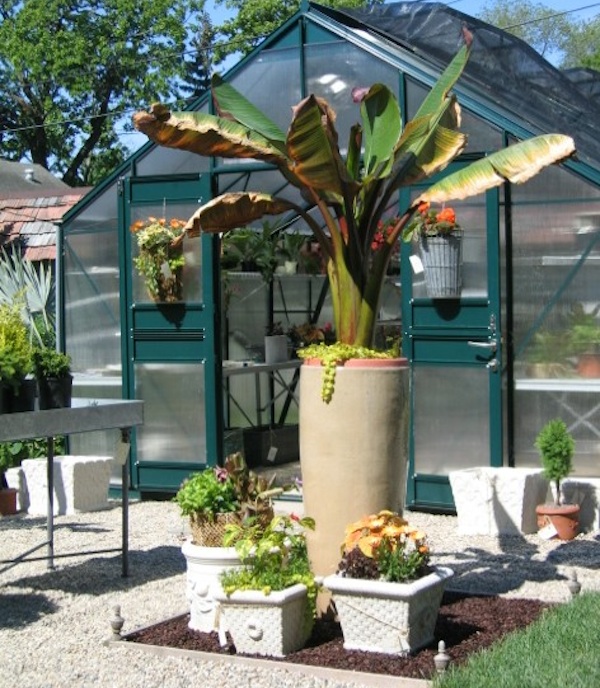 Own a hungry cat? Live in a sunless dungeon? Horticulturist Allan Smessaert knows a way around those obstacles.
Own a hungry cat? Live in a sunless dungeon? Horticulturist Allan Smessaert knows a way around those obstacles.
Allan Smessaert likes to joke that his thumb is “green to the shoulder,” and with good reason. He started growing marigold seeds that his mother gave him when he was 7 years old. By age 15, he was collecting thrown-out clippings and cuttings from his friends and neighbors, nurturing them to bloom before selling them at an annual “plant garage sale.”
“I’ve been doing a variation of that ever since,” says Allan, who now travels the country collecting and vending plants for
Acorn Markets. He specializes in unusual plants that add a bold touch to indoor and outdoor displays—you may have seen his greenery at
Renegade Craft Fair or
Randolph Street Market.
Now that the dark days of winter have made sunlight a precious commodity in Chicago, Allan helps his buyers navigate the challenges of indoor growing. With his guidance, we’ve assembled a list of plants and tips that will help burgeoning gardeners flourish in the face of five common obstacles.
 Challenge: Thumb Not Green Enough
Challenge: Thumb Not Green Enough
Allan acknowledges that some people have “an innate talent for gardening,” but he says that anyone can develop their growing skills with a little time and patience. He recommends that beginners try out a
tillandsia (above), a genus of flowering evergreen plants sometimes known as air plants because they grow without soil. These spindly, oddly shaped plants require no guesswork—just a watering schedule (try setting a calendar alert for every two to three days as a reminder).
For beginner-friendly potted plants, Allan recommends snake plants (below), ZZ plants, and spathiphyllums such as peace lilies. Although you might be tempted to start your indoor garden with cacti or succulents, Allan cautions that “most people lack the light required for successful growth” and that the watering requirements can get confusing.
 Challenge: Cave-Like Apartment
Challenge: Cave-Like Apartment
Not every Chicagoan is lucky enough to have a south-facing window—or enough natural light to power a pocket calculator. To overcome a lack of sun, Allan suggests investing in a small grow light or at least full-spectrum light bulbs, which mimic natural sunbeams.
To minimize disruption to your design scheme, Allan endorses setting up a “plant spa,” an out-of-the-way place for a grow lamp, that will allow you to rotate plants in and out of the light for one day a week or even one week per month. There are also a few plants that can survive in lower-light areas, including small palms, Chinese evergreens, Amazon lilies, and tillandsia with green foliage.
Challenge: Plant-Munching Pets
Outdoor growers have to protect their gardens from rabbits and salad-craving neighbors, but it’s harder to defend against indoor predators. “With pets around, cats in particular, you should always try to keep a small pot of grass growing,” Allan says. “It can be lawn-type grass, oat, or even wheatgrass.” This allows pets to “satisfy their craving for leafy greens and help keep them away from more prized plants.” If diversion plants don’t satisfy your pet’s hunger, Allan recommends
Grannick’s Bitter Apple spray, a safe way to make your foliage seem a lot less yummy.
Pet owners should also keep in mind that some plants can be poisonous to pets. “It’s unlikely a house pet will ingest enough of a plant to cause harm,” Allan says, “[but] you should be aware of those that have the potential for illness.” Peruse
this fact sheet from the New York Botanical Garden for more info.
 Challenge: A Strict Design Scheme
Challenge: A Strict Design Scheme
Plants don’t have to work in opposition to your design scheme. In fact, they can become a part of it. “I love plants that have sculptural forms or those that can stand in for living art due to their growth habit, color, or display methods,” Allan says. However, he admits that sculptural plants like the tillandsia above often look best where there isn’t much light—and this is where that “plant spa” can really come in handy. You could purchase two identical plants and rotate them between a bright area and your chosen low-light space. Or, for a “one-of-a-kind” plant, you can “simply move it to its preferred conditions when you aren’t home [and move] it to your preferred location when you are home.”
It also pays to get creative with your planters. Allan’s favorite standbys include glass jars, decorative branches and logs, and vintage teacups. “I’ve used a jewelry stand to hang mounted orchids from,” he says. “I’ve [also] been potting ferns in lava rock. … Tin chicken feeders are my current container whim.”
 Challenge: Moving Plants from Windowsill to Patio
Challenge: Moving Plants from Windowsill to Patio
Once the ice thaws, you may want to give your plants a breath of fresh air. “Most plants transition well between indoors and out,” Allan says, although those with delicate leaves (such as ferns) or larger leaves (such as banana trees) are prone to wind damage. Wait until night temperatures level out at 50 degrees Fahrenheit or above, then slowly transition your plants from a fully shaded outdoor area to brighter conditions, moving them closer to full sunlight every two days. “Remember that if you were to sit out in the sun all day after a long winter inside, you would sunburn,” Allan says. “The same is true of plants, except their burn will not fade over time.”
You’ll want to bring your greenery back indoors around the first week of September. That way, “the plants will have an opportunity to adjust to the indoor light levels while we still have reasonably sunny weather outdoors.”
Photo: of Allan, Stephanie Bassos, Groupon; of plants, Allan Smessaert





 Own a hungry cat? Live in a sunless dungeon? Horticulturist Allan Smessaert knows a way around those obstacles.
Allan Smessaert likes to joke that his thumb is “green to the shoulder,” and with good reason. He started growing marigold seeds that his mother gave him when he was 7 years old. By age 15, he was collecting thrown-out clippings and cuttings from his friends and neighbors, nurturing them to bloom before selling them at an annual “plant garage sale.”
“I’ve been doing a variation of that ever since,” says Allan, who now travels the country collecting and vending plants for
Own a hungry cat? Live in a sunless dungeon? Horticulturist Allan Smessaert knows a way around those obstacles.
Allan Smessaert likes to joke that his thumb is “green to the shoulder,” and with good reason. He started growing marigold seeds that his mother gave him when he was 7 years old. By age 15, he was collecting thrown-out clippings and cuttings from his friends and neighbors, nurturing them to bloom before selling them at an annual “plant garage sale.”
“I’ve been doing a variation of that ever since,” says Allan, who now travels the country collecting and vending plants for  Challenge: Thumb Not Green Enough
Allan acknowledges that some people have “an innate talent for gardening,” but he says that anyone can develop their growing skills with a little time and patience. He recommends that beginners try out a
Challenge: Thumb Not Green Enough
Allan acknowledges that some people have “an innate talent for gardening,” but he says that anyone can develop their growing skills with a little time and patience. He recommends that beginners try out a  Challenge: Cave-Like Apartment
Not every Chicagoan is lucky enough to have a south-facing window—or enough natural light to power a pocket calculator. To overcome a lack of sun, Allan suggests investing in a small grow light or at least full-spectrum light bulbs, which mimic natural sunbeams.
To minimize disruption to your design scheme, Allan endorses setting up a “plant spa,” an out-of-the-way place for a grow lamp, that will allow you to rotate plants in and out of the light for one day a week or even one week per month. There are also a few plants that can survive in lower-light areas, including small palms, Chinese evergreens, Amazon lilies, and tillandsia with green foliage.
Challenge: Plant-Munching Pets
Outdoor growers have to protect their gardens from rabbits and salad-craving neighbors, but it’s harder to defend against indoor predators. “With pets around, cats in particular, you should always try to keep a small pot of grass growing,” Allan says. “It can be lawn-type grass, oat, or even wheatgrass.” This allows pets to “satisfy their craving for leafy greens and help keep them away from more prized plants.” If diversion plants don’t satisfy your pet’s hunger, Allan recommends
Challenge: Cave-Like Apartment
Not every Chicagoan is lucky enough to have a south-facing window—or enough natural light to power a pocket calculator. To overcome a lack of sun, Allan suggests investing in a small grow light or at least full-spectrum light bulbs, which mimic natural sunbeams.
To minimize disruption to your design scheme, Allan endorses setting up a “plant spa,” an out-of-the-way place for a grow lamp, that will allow you to rotate plants in and out of the light for one day a week or even one week per month. There are also a few plants that can survive in lower-light areas, including small palms, Chinese evergreens, Amazon lilies, and tillandsia with green foliage.
Challenge: Plant-Munching Pets
Outdoor growers have to protect their gardens from rabbits and salad-craving neighbors, but it’s harder to defend against indoor predators. “With pets around, cats in particular, you should always try to keep a small pot of grass growing,” Allan says. “It can be lawn-type grass, oat, or even wheatgrass.” This allows pets to “satisfy their craving for leafy greens and help keep them away from more prized plants.” If diversion plants don’t satisfy your pet’s hunger, Allan recommends  Challenge: A Strict Design Scheme
Plants don’t have to work in opposition to your design scheme. In fact, they can become a part of it. “I love plants that have sculptural forms or those that can stand in for living art due to their growth habit, color, or display methods,” Allan says. However, he admits that sculptural plants like the tillandsia above often look best where there isn’t much light—and this is where that “plant spa” can really come in handy. You could purchase two identical plants and rotate them between a bright area and your chosen low-light space. Or, for a “one-of-a-kind” plant, you can “simply move it to its preferred conditions when you aren’t home [and move] it to your preferred location when you are home.”
It also pays to get creative with your planters. Allan’s favorite standbys include glass jars, decorative branches and logs, and vintage teacups. “I’ve used a jewelry stand to hang mounted orchids from,” he says. “I’ve [also] been potting ferns in lava rock. … Tin chicken feeders are my current container whim.”
Challenge: A Strict Design Scheme
Plants don’t have to work in opposition to your design scheme. In fact, they can become a part of it. “I love plants that have sculptural forms or those that can stand in for living art due to their growth habit, color, or display methods,” Allan says. However, he admits that sculptural plants like the tillandsia above often look best where there isn’t much light—and this is where that “plant spa” can really come in handy. You could purchase two identical plants and rotate them between a bright area and your chosen low-light space. Or, for a “one-of-a-kind” plant, you can “simply move it to its preferred conditions when you aren’t home [and move] it to your preferred location when you are home.”
It also pays to get creative with your planters. Allan’s favorite standbys include glass jars, decorative branches and logs, and vintage teacups. “I’ve used a jewelry stand to hang mounted orchids from,” he says. “I’ve [also] been potting ferns in lava rock. … Tin chicken feeders are my current container whim.”
 Challenge: Moving Plants from Windowsill to Patio
Once the ice thaws, you may want to give your plants a breath of fresh air. “Most plants transition well between indoors and out,” Allan says, although those with delicate leaves (such as ferns) or larger leaves (such as banana trees) are prone to wind damage. Wait until night temperatures level out at 50 degrees Fahrenheit or above, then slowly transition your plants from a fully shaded outdoor area to brighter conditions, moving them closer to full sunlight every two days. “Remember that if you were to sit out in the sun all day after a long winter inside, you would sunburn,” Allan says. “The same is true of plants, except their burn will not fade over time.”
You’ll want to bring your greenery back indoors around the first week of September. That way, “the plants will have an opportunity to adjust to the indoor light levels while we still have reasonably sunny weather outdoors.”
Photo: of Allan, Stephanie Bassos, Groupon; of plants, Allan Smessaert
Challenge: Moving Plants from Windowsill to Patio
Once the ice thaws, you may want to give your plants a breath of fresh air. “Most plants transition well between indoors and out,” Allan says, although those with delicate leaves (such as ferns) or larger leaves (such as banana trees) are prone to wind damage. Wait until night temperatures level out at 50 degrees Fahrenheit or above, then slowly transition your plants from a fully shaded outdoor area to brighter conditions, moving them closer to full sunlight every two days. “Remember that if you were to sit out in the sun all day after a long winter inside, you would sunburn,” Allan says. “The same is true of plants, except their burn will not fade over time.”
You’ll want to bring your greenery back indoors around the first week of September. That way, “the plants will have an opportunity to adjust to the indoor light levels while we still have reasonably sunny weather outdoors.”
Photo: of Allan, Stephanie Bassos, Groupon; of plants, Allan Smessaert